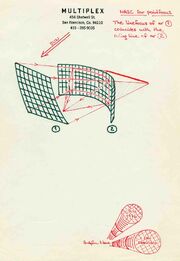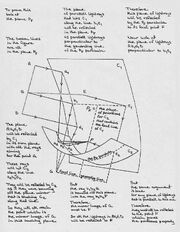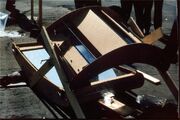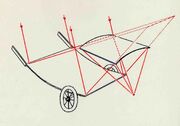No edit summary |
Tom Sponheim (talk | contribs) mNo edit summary |
||
| (19 intermediate revisions by 2 users not shown) | |||
| Line 1: | Line 1: | ||
| + | {{GoogleTranslateLinks}} |
||
| ⚫ | Ambjörn Naeve discovered that if you put |
||
| + | |||
| ⚫ | |||
| + | |||
| − | Here is Naeve using the device to melt copper![[File:Pointfocus-melting_copper.jpg|thumb|Click to enlarge]] |
||
| + | :See also: [http://solarcooking.wikia.com/wiki/Parabolic_solar_reflectors#Using_Two_Perpendicular_Troughs_to_Simulate_a_Paraboloid Parabolic solar reflectors - Using two perpendicular troughs to simulate a paraboloid] |
||
| − | Here is Naeves diagram of a Solar wheelbarrow |
||
| ⚫ | Ambjörn Naeve is a professor at the Royal Institute of Technology, in Stockholm, Sweden.<ref>In Swedish, the name of the institute is "Kungliga Tekniska högskolan". Its initials, KTH, are to be found in many of Naeve's files.</ref> In the 1970s, he discovered that if you put two parabolic trough solar concentrators in series at the right distance apart and in the right orientation, you can get a burning point of light. He has given permission to use his images here to show his device. He showed that by bending two pieces of reflective sheet material you can mimic a paraboloidal reflector. It is much easier to bend two pieces than to bend and cut and bend and cut many times to make a parabolic dish. |
||
| ⚫ | |||
| + | Here is the proof. |
||
| − | I believe that Ambjörn Naeve made a great breakthrough back in the 1970"s when he discovered and worked on these concepts. |
||
| ⚫ | |||
| ⚫ | |||
| ⚫ | |||
| − | For me, I think the naeve cross holds the potential for people |
||
| + | {{clr}} |
||
| − | to design a combined trough solar cooker with a 2 hour cook time (or a 3 hour cook time) |
||
| + | Here are more images. (Click on the icon at the bottom-right corner of any image to enlarge it.) |
||
| − | (Which would be excellent in its own right) and then |
||
| + | [[File:Pointfocus-melting_copper.jpg|thumb|left|To demonstrate the high temperatutes it can reach, here is Naeve's device melting copper!]] |
||
| − | "reverse engineer" a dish from it. |
||
| + | [[File:PointFocus-wheelbarrel.jpg|thumb|Naeve's diagram of a solar wheelbarrow, which holds the troughs in proper alignment. The red lines represent rays of light being focused.]] |
||
| − | This combined trough or dish with a 2 or 3 hour UNATTENDED cooktime |
||
| + | {{clr}} |
||
| − | would be a wonderful breakthrough for solar cooks all over the world. |
||
| + | |||
| − | Brian White |
||
| + | Unfortunately, the Naeve Cross does have disadvantages. Compared with a paraboloid, more mirror material is needed. Also, since, the light is reflected twice, more of it is lost. The device does not share one of the main advantages of simple trough cookers, their tolerance of movements of the sun parallel to the length of the trough. This can allow a trough cooker to work for hours every day without any need for tracking the sun. But movement of the sun parallel to the length of one trough of a Naeve Cross is perpendicular to the length of the other, so the Naeve Cross has to be moved continuously or frequently to track the sun, like a paraboloid. |
||
| + | |||
| ⚫ | |||
| + | |||
| + | There are now commercially available cookers that use the Naeve Cross principle. See: [http://www.prosolartec.com/the-invention.html] |
||
| + | |||
| + | |||
| + | == Footnote == |
||
| + | |||
| + | <references/> |
||
| + | [[Category:Solar cooker designs]] |
||
Revision as of 22:20, 14 October 2013
Ambjörn Naeve is a professor at the Royal Institute of Technology, in Stockholm, Sweden.[1] In the 1970s, he discovered that if you put two parabolic trough solar concentrators in series at the right distance apart and in the right orientation, you can get a burning point of light. He has given permission to use his images here to show his device. He showed that by bending two pieces of reflective sheet material you can mimic a paraboloidal reflector. It is much easier to bend two pieces than to bend and cut and bend and cut many times to make a parabolic dish. Here is the proof.

Diagram of device.

Proof.
Here are more images. (Click on the icon at the bottom-right corner of any image to enlarge it.)

To demonstrate the high temperatutes it can reach, here is Naeve's device melting copper!

Naeve's diagram of a solar wheelbarrow, which holds the troughs in proper alignment. The red lines represent rays of light being focused.
Unfortunately, the Naeve Cross does have disadvantages. Compared with a paraboloid, more mirror material is needed. Also, since, the light is reflected twice, more of it is lost. The device does not share one of the main advantages of simple trough cookers, their tolerance of movements of the sun parallel to the length of the trough. This can allow a trough cooker to work for hours every day without any need for tracking the sun. But movement of the sun parallel to the length of one trough of a Naeve Cross is perpendicular to the length of the other, so the Naeve Cross has to be moved continuously or frequently to track the sun, like a paraboloid.
Nevertheless, Naeve's device is potentially very useful. Here is his story of the discovery and how he tried to spread the knowledge.
There are now commercially available cookers that use the Naeve Cross principle. See: [1]
Footnote
- ↑ In Swedish, the name of the institute is "Kungliga Tekniska högskolan". Its initials, KTH, are to be found in many of Naeve's files.
